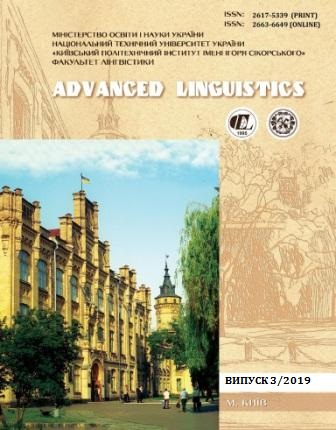FORMATION OF TEENAGER’S IDIOLECT IN DONNA TARTT’S NOVEL “THE GOLDFINCH” AND SPECIFICS OF ITS TRANSLATION
DOI:
https://doi.org/10.20535/2617-5339.2019.3.169370Ключові слова:
idiolect, slang, idiostyle, translation, translation proceduresАнотація
In the article the means of forming an adolescent idiollect and the peculiarities of its reproduction in translation are considered. The study was focused on the idiolects of the central characters of the Donna Tart’s novel “The Goldfinch” – Theo and Boris. The article deals with such concepts as idiostyle, author's style and idiolect, as well as the definition of idiolect as a set of formal and stylistic peculiarities inherent to the speech of a separate carrier of a certain language. On the example of Donna Tart’s novel “The Goldfinch”, it was found out that the means of forming teen idiolect are slang, argots, jargon – they are common to the teen's idiolect in general. In addition, it was found that the elements of the idiolect of each character are words and expressions that reflect his personal life experience: in Theo’s speech such vocabulary includes psychological and art-study terms, a sophisticated and intelligent style of utterances, and later – obscene words and words, borrowed from Russian, Ukrainian and Polish, which appeared in Theo’s speech after he got acquainted with Boris; Boris, a son of a Ukrainian emigrant who had mixed Ukrainian-Polish origin, uses in speech lots of obscene words, borrowings from Ukrainian, Russian and Polish. The translation of the novel by Viktor Shovkun was analyzed and it was found that the translator significantly softened and to some extent neutralized the language of adolescents. A series of translation procedures (classification by Vinogradov), which were used for the reproduction of idiolects of the central characters of the novel, were considered. After the analysis of 300 linguistic units selected by the method of full selection, the frequency of the translation procedures usage and the expediency and correctness of their application were determined. It was noted that the main difficulties of the translation of idiolects is the preservation of connotation and stylistic coloring of idiolects in translation, the transmission of idioms, the adaptation of idiolect to the language of translation and its correlation with the broadcast of the readers. Prospects for further research on the means of forming idiolects and ways of their translation were determined.Посилання
Alekseeva, Y. S. (2004). Vvedenye v perevodovedenye: uchebnoe posobye dlia studentov fylolohycheskykh y lynhvystycheskykh fakultetov vuzov. Moskva: Akademyia. [Introduction to the science of translation]. [in Russian]
Vynohradov, V. S. (2001). Vvedenye v perevodovedenye (obshchye y leksycheskye voprosy). Moskva: Yzdatelstvo ynstytuta obshcheho sredneho obrazvanyia RAO. [Introduction to the science of translation]. [in Russian]
Voloshuk, V. I. (2008). Indyvidualnyi avtorskyi styl, idiolekt, idiostyl: pytannia treminolohii. Naukovo-metodychnyi zhurnal. Filolohiia. Movoznavstvo, 79, 5–8. [Individual author’s style, idiolect, idiostyle: questions of terminology]. [in Ukrainian]
Holykova, Zh. A. (2004). Perevod s anhlyiskoho na russkyi: ucheb. posobye. Moskva: Novoe znanye. [Translation from English to Russian]. [in Russian]
Stavytska, L. (2009). Pro termin idiolekt. Ukrainska mova, 4, 3–15. Retrieved from http://dspace.nbuv.gov.ua/bitstream/handle/123456789/6063/01-Stavitska.pdf?sequence=1 [About the term “idiolect”]. [in Ukrainian]
Tartt, D. (2018). Shchyhol. Kharkiv: Knyzhkovyi Klub “Klub Simeinoho Dozvillia”.[The Goldfinch]. [in Ukrainian]
Ter-Mynasova, S. H. (2008). Voina i myr yazykov i kultur. Moskva: Slovo. [War and peace of languages and cultures]. [in Russian]
Chetverikova, O. R. (n.d.). Formy realizatsii movlennia tineidzheriv. Retrieved from http://www.oljournal.in.ua/v7.27.pdf [Forms of realization of teenager’s language]. [in Ukrainian]
Yartseva, V. N. (Ed.). (1998). Bolshaia entsyklopedyia sovremennoho yazykovedenyia. Moskva. [Big thesaurus of modern linguistics]. NY: Little, Brown and Company.
Yermolenko, S. Ya. (n.d.). Movna norma. Retrieved from http://litopys.org.ua/ukrmova/um55.htm [The norm of language]. [in Ukrainian]
Tartt, D. (2016). The Goldfinch. NY: Little, Brown and Company.
##submission.downloads##
Опубліковано
Номер
Розділ
Ліцензія
Наше видання використовує положення про авторські права CREATIVE COMMONS для журналів відкритого доступу.
Автори, які публікуються у цьому журналі, погоджуються з наступними умовами:
1. Автори залишають за собою право на авторство своєї роботи та передають журналу право першої публікації цієї роботи на умовах ліцензії Creative Commons Attribution License, котра дозволяє іншим особам вільно розповсюджувати опубліковану роботу з обов'язковим посиланням на авторів оригінальної роботи та першу публікацію роботи у цьому журналі.
2. Автори мають право укладати самостійні додаткові угоди щодо неексклюзивного розповсюдження роботи у тому вигляді, в якому вона була опублікована цим журналом (наприклад, розміщувати роботу в електронному сховищі установи або публікувати у складі монографії), за умови збереження посилання на першу публікацію роботи у цьому журналі.

